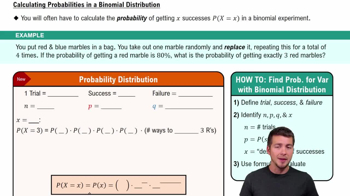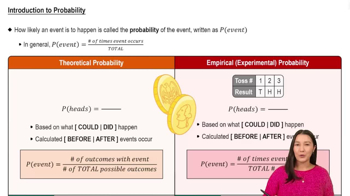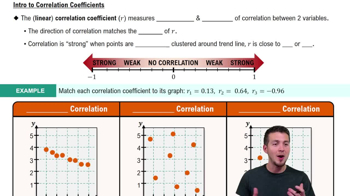A gardener plants 8 seeds, and each has a 65% probability of germinating successfully. Find the probability that less than 4 seeds germinate successfully.
Table of contents
- 1. Intro to Stats and Collecting Data1h 14m
- 2. Describing Data with Tables and Graphs1h 55m
- 3. Describing Data Numerically2h 5m
- 4. Probability2h 16m
- 5. Binomial Distribution & Discrete Random Variables3h 6m
- 6. Normal Distribution and Continuous Random Variables2h 11m
- 7. Sampling Distributions & Confidence Intervals: Mean3h 23m
- Sampling Distribution of the Sample Mean and Central Limit Theorem19m
- Distribution of Sample Mean - Excel23m
- Introduction to Confidence Intervals15m
- Confidence Intervals for Population Mean1h 18m
- Determining the Minimum Sample Size Required12m
- Finding Probabilities and T Critical Values - Excel28m
- Confidence Intervals for Population Means - Excel25m
- 8. Sampling Distributions & Confidence Intervals: Proportion1h 12m
- 9. Hypothesis Testing for One Sample3h 29m
- 10. Hypothesis Testing for Two Samples4h 50m
- Two Proportions1h 13m
- Two Proportions Hypothesis Test - Excel28m
- Two Means - Unknown, Unequal Variance1h 3m
- Two Means - Unknown Variances Hypothesis Test - Excel12m
- Two Means - Unknown, Equal Variance15m
- Two Means - Unknown, Equal Variances Hypothesis Test - Excel9m
- Two Means - Known Variance12m
- Two Means - Sigma Known Hypothesis Test - Excel21m
- Two Means - Matched Pairs (Dependent Samples)42m
- Matched Pairs Hypothesis Test - Excel12m
- 11. Correlation1h 6m
- 12. Regression1h 50m
- 13. Chi-Square Tests & Goodness of Fit1h 57m
- 14. ANOVA1h 57m
5. Binomial Distribution & Discrete Random Variables
Binomial Distribution
Problem 5.2.13c
Textbook Question
Binomial Probability Formula. In Exercises 13 and 14, answer the questions designed to help understand the rationale for the binomial probability formula.
Guessing Answers Standard tests, such as the SAT, ACT, or Medical College Admission Test (MCAT), typically use multiple choice questions, each with five possible answers (a, b, c, d, e), one of which is correct. Assume that you guess the answers to the first three questions.
c. Based on the preceding results, what is the probability of getting exactly one correct answer when three guesses are made?
 Verified step by step guidance
Verified step by step guidance1
Step 1: Recognize that this is a binomial probability problem. The binomial probability formula is given by: P(X = k) = (n choose k) * p^k * (1-p)^(n-k), where 'n' is the number of trials, 'k' is the number of successes, 'p' is the probability of success on a single trial, and '1-p' is the probability of failure.
Step 2: Identify the values for the problem. Here, 'n' (number of trials) is 3 because there are three questions, 'k' (number of successes) is 1 because we are looking for exactly one correct answer, and 'p' (probability of success) is 1/5 = 0.2 because there is one correct answer out of five choices.
Step 3: Calculate the binomial coefficient (n choose k), which is given by the formula: (n choose k) = n! / [k! * (n-k)!]. For this problem, (3 choose 1) = 3! / [1! * (3-1)!] = 3.
Step 4: Substitute the values into the binomial probability formula. Using the formula P(X = k) = (n choose k) * p^k * (1-p)^(n-k), substitute n = 3, k = 1, and p = 0.2. This gives: P(X = 1) = (3 choose 1) * (0.2)^1 * (1-0.2)^(3-1).
Step 5: Simplify the expression step by step. First, calculate (3 choose 1), then calculate (0.2)^1, and finally calculate (1-0.2)^2. Multiply these values together to find the probability of getting exactly one correct answer.
 Verified video answer for a similar problem:
Verified video answer for a similar problem:This video solution was recommended by our tutors as helpful for the problem above
Video duration:
5mPlay a video:
Was this helpful?
Key Concepts
Here are the essential concepts you must grasp in order to answer the question correctly.
Binomial Probability Distribution
The binomial probability distribution models the number of successes in a fixed number of independent Bernoulli trials, each with the same probability of success. In this context, a 'success' is defined as correctly guessing an answer on a multiple-choice test. The formula for calculating the probability of exactly k successes in n trials is given by P(X = k) = (n choose k) * p^k * (1-p)^(n-k), where p is the probability of success on a single trial.
Recommended video:
Guided course

Calculating Probabilities in a Binomial Distribution
Probability of Success and Failure
In the context of guessing answers on a multiple-choice test, the probability of success (correctly guessing an answer) is 1/5, since there is one correct answer out of five options. Conversely, the probability of failure (incorrectly guessing) is 4/5. Understanding these probabilities is crucial for applying the binomial formula to calculate the likelihood of achieving a specific number of correct answers.
Recommended video:

Introduction to Probability
Combinatorial Coefficient
The combinatorial coefficient, often represented as 'n choose k' or C(n, k), calculates the number of ways to choose k successes from n trials. This is essential in the binomial probability formula, as it accounts for the different sequences in which successes and failures can occur. For example, if you want to find the probability of getting exactly one correct answer out of three guesses, you need to determine how many different ways this can happen.
Recommended video:
Guided course

Correlation Coefficient

 6:00m
6:00mWatch next
Master The Binomial Experiment with a bite sized video explanation from Patrick
Start learningRelated Videos
Related Practice
Multiple Choice
